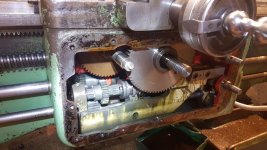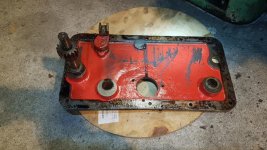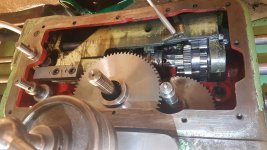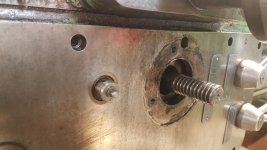Wow, I am really impressed about the number of helpful replies. This was my first post here and I really did not expect such a great feedback. Thanks to you all, I guess you'll see more of me here from now on

I first tried the approach with some prying tools (used some cheap chisels) and after I overcame my fear to break anything and used some more force, it simply popped of. The dowels stayed in the plate and were still intact and provided a tight fit when I put the plate back on. I got it all together again yesterday and even produced my first chips later that day. Everything seems to work and I couldn't be happier. Ok well, maybe if I had some more tools I'd be

@Tyrone
Removing the saddle would be a good thing because I want to clean the underside and fix the semi-automatic bed lubrication. But to lift it, I'll first need a engine hoist or something. I think, I'll stick with manual lubing for now and when time and hoist comes around, I'll dedicate myself to the saddle. Also, I have to replace the handwheel rod then. It's totally worn out because the oil passages were packed with schmoo and probably didn't see any lubrication for ages.
The data plate for the feed box has been removed by a previous owner - pretty sure the reason was exactly what you mentioned. I got the plate with the machine and it's in a very good condition.
The headstock sight glass caught my eye as well when I first saw it. It seems that hot chips made it suffer and you can't really see well through it but it kinda still lives

I think the lathe overall is in quite a good condition (it was quite cheap) but I can't say much about the accuracy since it's not aligned at the moment and I will move it again in the next days.
Maybe I'll start a new thread about the machine, if people are interested.
I really learned a lot about this machine in the past two weeks and since I never fixed or maintained a lathe before, it's quite the adventure.
@bosleyjr
I have the original user's manual for my lathe, looks like it's the same as on lathes.co.uk. It's a pity that I can't find a repair or shop manual for it.
@Bill D
Thanks for the instructions. I would have done it your way if it had come to that.
Again, thanks to you all- I know where I'll turn if i need some more advice. And that's a given.
Greetings
Did I mention that I dropped a screw in the apron when I was fixing the compound? Yeah, well. That's me










 Thanks!
Thanks!



 Thanks!
Thanks!






